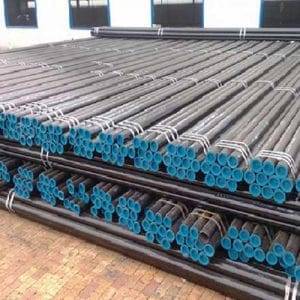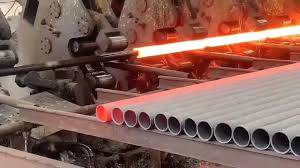Introduction

In today’s construction industry, selecting the right materials is crucial to ensuring durability, efficiency, and cost-effectiveness. Among the myriad choices available, carbon steel pipes have emerged as a favored option due to their exceptional properties and versatility. This blog explores in-depth the advantages of using carbon steel pipes in construction, shedding light on why they are preferred over other materials.
Properties of Carbon Steel Pipe
Carbon steel pipes derive their strength from their composition, primarily consisting of carbon and iron. This composition lends them remarkable tensile strength, hardness, and resistance to wear and tear, making them suitable for demanding applications in construction. Additionally, carbon steel pipes exhibit excellent weldability and machinability, facilitating ease of installation and modification on-site.
Advantages of Carbon Steel Pipe
- Durability and Strength: One of the foremost advantages of carbon steel pipes is their durability under various environmental conditions. They are resilient against corrosion, making them ideal for both indoor and outdoor applications.
- Cost-Effectiveness: Carbon steel pipes are cost-effective compared to other materials like stainless steel or copper. Their affordability does not compromise on quality, making them a preferred choice for budget-conscious projects without sacrificing performance.
- Versatility in Applications: From structural supports to plumbing systems and HVAC installations, carbon steel tubes find extensive use across diverse construction sectors. Their adaptability and reliability ensure they meet the stringent demands of modern construction projects.
- High Temperature and Pressure Resistance: Carbon steel tubes excel in high-pressure and high-temperature environments, such as in industrial piping systems and oil refineries. Their robustness and thermal stability make them indispensable for conveying fluids and gases under extreme conditions.
Applications in Construction
Carbon steel pipes play a vital role in various construction applications:
| Application | Description |
|---|---|
| Structural Support | Used in constructing buildings, bridges, and infrastructure. |
| Plumbing Systems | Essential for water supply and drainage networks. |
| HVAC Installations | Integral to heating, ventilation, and air conditioning units. |
| Industrial Piping | Utilized in oil and gas pipelines, chemical plants, etc. |
Manufacturing Process of Carbon Steel Pipes
The manufacturing process of carbon steel pipes involves several stages to ensure high quality and reliability in construction applications. Here’s an overview of the typical process:
- Raw Material Preparation: The process begins with the selection of high-quality raw materials, primarily iron ore and carbon sources such as coal or petroleum coke. These materials are smelted in a blast furnace to produce molten iron.
- Steelmaking: The molten iron is then refined in a steelmaking furnace, where additional alloying elements like manganese, silicon, and carbon are added to achieve the desired steel composition. This step is crucial for imparting specific properties such as strength, hardness, and corrosion resistance to the steel.
- Forming: After steelmaking, the molten steel is cast into billets or blooms of suitable sizes. These semi-finished products are then formed into cylindrical shapes through processes like hot rolling or cold drawing, depending on the desired dimensions and specifications of the final carbon steel tubes.
- Welding (if applicable): In cases where welded pipes are required, the formed steel billets or coils are welded longitudinally to create seamless or welded pipe configurations. This process ensures structural integrity and uniformity along the length of the pipe.
- Heat Treatment: Depending on the application requirements, the pipes may undergo heat treatment processes such as annealing, normalizing, or quenching and tempering. Heat treatment enhances the mechanical properties of the steel, improving its toughness and ductility.
- Surface Treatment: To protect against corrosion and enhance longevity, carbon steel pipes are often subjected to surface treatments such as galvanization, where a layer of zinc is applied to the exterior surface. Alternatively, epoxy coatings or polymer linings may be applied for specific applications requiring corrosion resistance.
- Quality Control: Throughout the manufacturing process, rigorous quality control measures are implemented to ensure that the carbon steel tubes meet industry standards and specifications. This includes dimensional checks, non-destructive testing, and material analysis to verify mechanical properties and durability.
Environmental Impact and Sustainability

While carbon steel production involves energy-intensive processes, advancements in technology have led to reduced emissions and improved energy efficiency. Moreover, carbon steel is highly recyclable, minimizing its environmental footprint over its lifecycle. This recyclability contributes to sustainable practices in construction, aligning with global efforts towards greener building materials.
Conclusion
In conclusion, the advantages of carbon steel pipes in construction are multifaceted and compelling. Their durability, cost-effectiveness, versatility, and resistance to harsh conditions make them indispensable for modern infrastructure projects. Despite environmental considerations, the recyclability and sustainable practices associated with carbon steel reinforce its position as a reliable choice for construction materials.
FAQ
Q:What types of carbon steel pipes are available?
A:Carbon steel pipes come in various types, such as seamless, welded, and ERW (Electric Resistance Welded), each suited to different applications based on strength and manufacturing requirements.
Q:How do carbon steel pipes compare to other materials like PVC or HDPE?
A:Carbon steel pipes offer superior strength and durability compared to PVC (polyvinyl chloride) and HDPE (high-density polyethylene), making them suitable for high-pressure applications and long-term use in construction.
Q:What are the considerations when choosing between seamless and welded carbon steel pipes?
A:Seamless pipes are preferred for high-pressure applications and environments where corrosion resistance is critical, whereas welded pipes are economical and widely used in structural and plumbing applications.
Q:Are carbon steel pipes suitable for underground installations?
A:Yes, carbon steel pipes are commonly used for underground installations due to their durability and resistance to soil corrosion, provided they are adequately coated and protected.
Q:How can I ensure the longevity of carbon steel pipes in my construction project?
A:Proper installation, regular maintenance, and corrosion prevention measures such as coatings and cathodic protection systems can significantly extend the lifespan of carbon steel pipes in construction.




